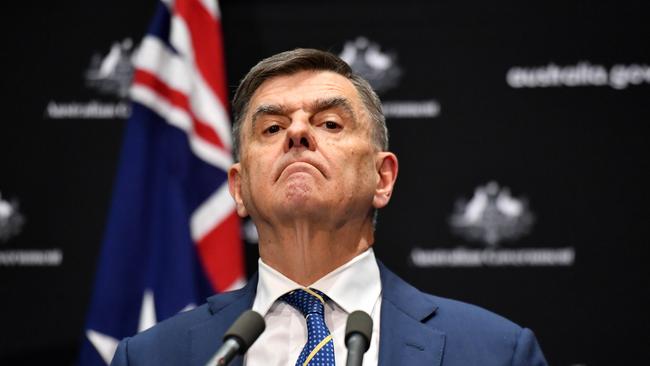
I understand governments, having made very costly interventions, have a strong incentive to “prove” how necessary they were. But surely the department could have been less ridiculous than claiming more than 0.5 per cent of the state’s entire population would have died? That’s far worse than anything Italy, Spain or New York has experienced so far. That’s a much greater share of Australians left dead than the vastly more lethal Spanish flu managed a century ago (0.28 per cent, according to recent research by Harvard economists), when doctors didn’t even have antibiotics.
Sweden, with a population half as large again as Victoria’s, has endured a little over 2000 deaths, and it has not imposed stage three lockdowns. Its cafes and bars have stayed open, with limited capacity.
“Some 36,000 Victorians would have died,” the 10-page analysis warns. “We have acted early and decisively to avoid catastrophic outcomes.”
New Zealand, which has become the poster child for fans of tough lockdown, now has 17 deaths attributed to COVID-19 — more than Australia, where states have gone nowhere near as far, adjusted for population.
Based on the simplistic Victorian analysis, Japan, South Korea and Sweden, which haven’t gone into lockdowns along Victorian lines, can expect deaths of 635,000, 256,000 and 51,500. These nations, all flirting with “catastrophe” according to Victoria, have respective death tolls so far of 330, 240 and 2021.
Garbage in, garbage out.
“Currently, the estimated Reff (the number of people an infected person will infect) in Victoria is 0.5; if Reff is kept below 1, an outbreak will slowly wane,” the Victorian analysis says.
Remarkably, analysis presented by Chief Medical Officer Brendan Murphy on Friday, based on an analysis of actual infection trends, estimated that the Reff was below 1 in every state and territory before the stage three lockdowns took effect late last month. In other words, the virus was waning in response to stage one and two restrictions (which caused much less economic damage) already.
However many lives the more onerous restrictions have saved, the cost is looking enormous and far more than we typically spend to save lives. If we’d followed the Swedish trajectory we might, crudely, have an extra 4500 fatalities by now (our population is 2½ times the size).
For the federal government alone, that works out at $48m per life saved, given the $214bn in budgeted federal assistance.
That’s more than 10 times the conventional estimate for the statistical value of a human life — “how much society is willing to pay to reduce the risk of death” — according to a 2014 federal government document from the Office of Best Practice Regulation.
And that’s only the raw cost to taxpayers of saving the life, not the bigger social and economic costs flowing from economic shutdown to slow the coronavirus.
Even if deaths mount considerably, as they are likely to, the excess focus on preventing COVID-19 deaths, as opposed to the 3000 other deaths a week in Australia, is likely to remain.
Ben Mol, a professor of obstetrics at Monash University, and Jonathan Karnon, a professor at Flinders University Medical Institute, argue what matters is life years saved, not lives per se. The median age of death from COVID-19 has been around 80 in Sweden and Australia.
This suggests an even greater over-reaction. “Assuming a willingness to pay $70,000 per life year saved, then Australia would, from a rational perspective, be prepared to pay not more than $3.8bn to justify the gained life years,” they tell Inquirer.
That’s about 1.2 per cent of the $320bn the government and Reserve Bank intend to spend to counteract stage three lockdowns, for which there’s no evidence.
“Non-emergency healthcare has stopped, resulting in significantly fewer people presenting with acute heart problems, stroke and other serious illnesses, which is causing unnecessary deaths. Some cancer screening has also ceased,” the two doctors say.
“Sweden is saving the 50-year-old from dying from cancer, stroke or a heart attack, while Australia saves the 79-year-old to die from COVID-19 at an economic cost which is a multiple of what we would normally allow in health care. We all wish we could save both, but that bid is not on the table,” they add.
To be sure, Sweden’s economy, heavily linked to the rest of Europe, still more or less in lockdown, has been hit hard, but its businesses have a greater chance of hanging on. Its jobless rate is expected to rise from about 7 per cent to 10 per cent, a far smaller increase than is expected here.
And people can still sit in the park, swim at the local pool and meet friends for dinner — which, while hard to put a dollar figure on, must be worth something.
Sweden refutes the idea that everyone would be cowering in their home even without severe restrictions. After all, in Europe 5 per cent of deaths from coronavirus are under-60s, and swathes of the population have it already.
Sweden won’t have to borrow as much, either: according to the International Monetary Fund, Australia’s stimulus effort — the biggest in the world — amounts to 10.6 per cent of gross domestic product; Sweden’s is 2.2 per cent.
The crisis has created an opportunity for extremists to remodel society with a much larger role for government, as former treasurer Peter Costello warned this week. Calls to permanently lift taxes, turn the JobKeeper payment into a universal basic income and nationalise swathes of the economy have grown louder.
The health sector unions and doctors will probably use the virus as leverage to obtain pay increases, even though only 43 people were in intensive care as of Friday because of coronavirus. Others simply enjoy seeing the growth of state control. After World War II, businesses that benefited from controls wanted to keep things as they were.
“No Australian wants to see hundreds of Australians dying a day of coronavirus,” Murphy said yesterday. No one does, but we need to be aware of the costs of saving some lives over others. Sadly, resources are limited.
We must ask whether we’re prepared to pay similar sums to save individual lives in the future. From the health sector’s standpoint, taxpayers can never spend too much on health. On April 1, Victoria ordered an extra 4000 intensive care beds (from existing capacity of 450), 551 million gloves and 100 million masks and 14.5 million gowns at a cost of about $2.5bn. Only 20 people were in an intensive care unit in Victoria yesterday from coronavirus.
When pandemic best-practice guides are written in coming years, having a well-resourced health system is likely to figure more highly than shutting down swathes of the economy. We might not be able to afford another response like this.



The most absurd document published by an Australian government in recent times must be from Victoria’s Health and Human Services Department, which claimed 36,000 Victorians would have died from COVID-19 without the tough lockdowns brought in by Premier Daniel Andrews.